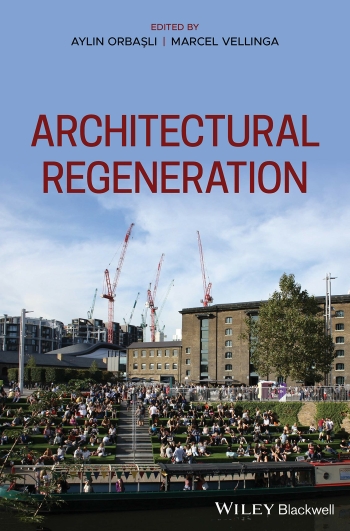Architectural Regeneration
Architectural Regeneration, Edited by Aylin Orbasli and Marcel Vellinga, Wiley Blackwell, 2020, 348 pages, several photographs (most in colour) and illustrations.
Almost every IHBC member must be involved in the process of architectural regeneration or at least have an interest in it, due to the very purpose of the institute. This book will thus have value to all members. It provides a comprehensive and detailed overview of the evolution and process of regeneration, conservation, rehabilitation and revitalisation of architectural heritage.
Many of us may know architectural regeneration as ‘adaptive re-use’ but the authors see it as a wider activity, ‘…the collective activities of re-using, adapting and evolving existing buildings… underpinned by the principles of environmental, social and cultural sustainability’. Accordingly, the book grapples, in an even-handed way, with area-based regeneration, placemaking, the historic urban landscape approach; and the perennial thorny issues of significance, facadism, authenticity and whether interventions, extensions and new build should be traditional or not, among others.
Architectural Regeneration is not so much a guide to best practice nor a gazetteer of successful projects, although it does cross-reference examples from around the world. Nor is it, as such, an advocate for architectural regeneration over redevelopment or decay (curated or not), although the environmental, economic, intangible, cultural and social benefits are clearly articulated. It is first and foremost an academic study of the many political, social, cultural, financial and practical factors that have influenced the evolution of the process of architectural regeneration. It examines how the combined processes of globalisation, urbanisation, environmental change, changing cultural values, population growth and rapid technological development have resulted in an increasingly complex, dynamic and inter-related world. It looks in detail at how these factors have played a part in the conceptualisation, implementation and perception of the conservation of (not necessarily) historic buildings.
As an academic study, it is aimed primarily at students of architecture, building conservation, urban and environmental design, sustainability, and urban regeneration, who can use it as a reference to gain an understanding of how the conservation movement and the related professions have got us to where we are today. All 16 contributors hold, or have held, academic teaching positions at universities, so it is perhaps not surprising that the text’s value is enhanced for readers by extensive bibliographies and suggestions for further reading at the end of each chapter. Assertions about causality and effect, analysis, hypotheses and theories are also cross-referenced to their originators. Many of the contributors have also been, or still are, practitioners and so have been able to alloy practical experience with high-level understanding.
The photographs and illustrations provide some relief, but the book is not an easy read. Even so, hardworking members of the institute, who are under pressure to complete their next committee report, heritage statement or repair methodology to meet their employer’s or clients’ deadlines, would benefit by stepping back from time to time to read this book, and reassess their daily toil with a better understanding of the historical and international context in which they work.
In addition to the theorising, the book provides three specific case studies, from Oxford, Istanbul and Portugal, by contributors who were directly involved in the projects. In the former, Geoffrey Randall examines the conversion of Oxford Castle and Prison into a hotel. He rightly acknowledges its success, commercially and professionally, although some might query whether the enlargement of the prison windows sensitively ‘retains the prison’s austerity’, as he contends.
As well as editing, the contributions Orbasli and Vellinga make lucid contributions, individually and in collaboration. Indeed, their opening chapter, Architectural Regeneration and its Theoretical Context, effectively provides an executive summary of the book’s content, and might be sufficient for those with a limited attention span or lack of time.
This article originally appeared as ‘A matter of context’ in Context 169, published by the Institute of Historic Building Conservation (IHBC) in September 2021. It was written by John Hinchliffe, heritage consultant.
--Institute of Historic Building Conservation
Related articles on Designing Buildings
IHBC NewsBlog
IHBC Context 183 Wellbeing and Heritage published
The issue explores issues at the intersection of heritage and wellbeing.
SAVE celebrates 50 years of campaigning 1975-2025
SAVE Britain’s Heritage has announced events across the country to celebrate bringing new life to remarkable buildings.
IHBC Annual School 2025 - Shrewsbury 12-14 June
Themed Heritage in Context – Value: Plan: Change, join in-person or online.
200th Anniversary Celebration of the Modern Railway Planned
The Stockton & Darlington Railway opened on September 27, 1825.
Competence Framework Launched for Sustainability in the Built Environment
The Construction Industry Council (CIC) and the Edge have jointly published the framework.
Historic England Launches Wellbeing Strategy for Heritage
Whether through visiting, volunteering, learning or creative practice, engaging with heritage can strengthen confidence, resilience, hope and social connections.
National Trust for Canada’s Review of 2024
Great Saves & Worst Losses Highlighted
IHBC's SelfStarter Website Undergoes Refresh
New updates and resources for emerging conservation professionals.
‘Behind the Scenes’ podcast on St. Pauls Cathedral Published
Experience the inside track on one of the world’s best known places of worship and visitor attractions.
National Audit Office (NAO) says Government building maintenance backlog is at least £49 billion
The public spending watchdog will need to consider the best way to manage its assets to bring property condition to a satisfactory level.

















